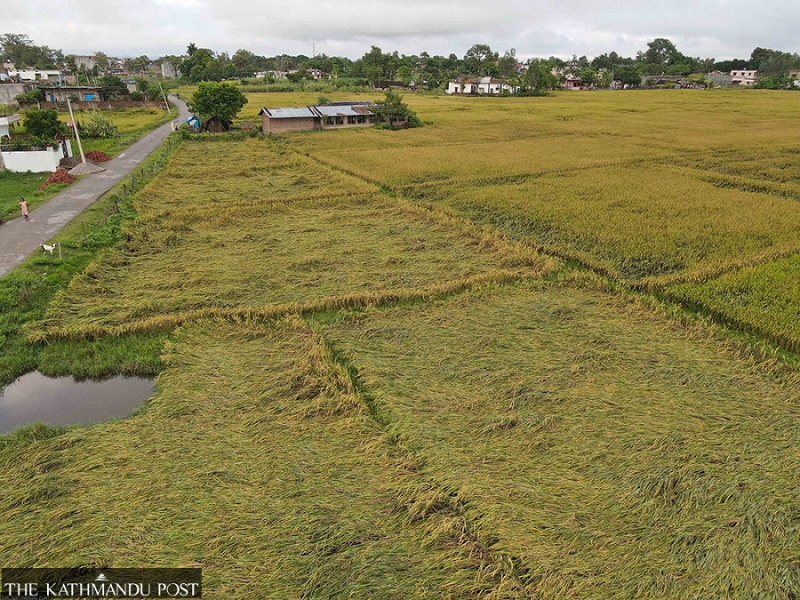
Paddy is Nepal’s biggest earning farm commodity, with tens of thousands of farmers relying on its income. Post File Photo
When many economic indicators—from the service sectors to the government's spending performance—were below par, some saw the silver lining in the agriculture sector.
But it’s official now that it too suffered.
Nepal’s paddy harvest is expected to shrink to a five-year low to 5.13 million tonnes this fiscal year caused by unseasonal October rainfall and experts say it may cause further upward pressure on inflation and downward pressure on the economy.
Paddy is Nepal’s biggest earning farm commodity, with tens of thousands of farmers relying on its income.
As the government is struggling to ensure chemical fertiliser for winter crops and upcoming summer crops due to the cost factor—-prices have gone up sharply globally—the agriculture sector is staring at a severe crisis.
A preliminary paddy output report released by the Ministry of Agriculture and Livestock Development on Sunday, shows paddy output may drop 8.74 percent year-on-year this fiscal year, ending mid-July 2022.
According to the ministry, paddy productivity or yield dropped 9.09 percent year-on-year.
Farmers harvested 5.62 million tonnes of paddy, a historic high output last fiscal year, due to good monsoon rains and an abundant supply of farmhands.
Against this backdrop, experts say, Nepal could face more downward economic pressure in 2022 than it did in 2021.
This fiscal year, everything was favourable. There was timely and above normal monsoon rains, no shortage of chemical fertiliser and farm workers. Based on the indicators, the agriculture ministry had projected a record paddy harvest, something close to 6 million tonnes.
“The heavy downpour in October shattered all the hopes,” Ram Krishna Regmi, chief statistician at the ministry, told the Post. “The only reason for reduced production was the unseasonal rainfall,” he said.
“The rainfall in October squeezed the income of farmers across the country.”
Out of seven provinces, only Gandaki saw a positive growth in harvest.
Heavy rainfall is unusual in Nepal in October, which is traditionally outside the monsoon season.
The rains started on October 17 in the western part of Nepal and then moved to the eastern part on October 19 claiming lives, damaging roads and bridges and other physical infrastructure in various districts.
Nepal’s economic wellbeing is intimately linked to the rainy season. Water from the skies is the lifeblood of Nepal's Rs4.26 trillion economy which is farm-dependent, as nearly two-thirds of the farmlands are rain-fed.
But the October unseasonal rains spelt disaster.
Paddy is transplanted across most of Nepal in June and harvested in October.
And the destruction of paddy is a major setback for Nepal’s economy. Paddy alone contributes around 7 percent to the national gross domestic product, and is the major income source for more than half of the population.
Economist Jagdish Chandra Pokhrel said nearly a double digit fall in paddy output may slightly affect the economic growth rates but it’s fallout will be reflected on farmers' income.
“Farmers have lost income. Now, low production will drive up imports,” said Pokhrel. “The unexpected domestic food price fluctuations remains a possibility so it is crucial that the country be prepared to address dangerous food price hikes when and if they unfold.”
In the last fiscal year that ended mid-July, the import of cereals increased by Rs22.71 billion, crossing Rs79 billion. Out of the total cereal imports, imports of rice and paddy amounted to Rs27.62 billion and Rs20.54 billion respectively.
“The country will not suffer food shortages but food inflation may rise as Nepal has to plug the deficit through imports this year,” said Regmi.
According to the Agriculture Ministry, the largest damage has been witnessed in Sudurpaschim province with paddy production falling 31.49 percent.
“Most of the farmers in Sudurpaschim are not able to sell their paddy because of the quality. Paddy was submerged for days,” said Regmi.
The low quality of rice in Nepal will allow the import volume to rise, filling growing demand for fine rice, according to Pokhrel.
Imports are expected to balloon—both in quantity and value.
Trade experts say that imports may touch a Rs1 trillion figure, for the first time, in the first half of this fiscal year.
In the first five months of the current fiscal year, imports swelled 60 percent to Rs838.40 billion, according to the Department of Customs statistics.
“It’s alarming. The government should intervene immediately. The first thing is to stop imports growth at such alarming levels,” said Pokhrel.
Nepal’s economy was recovering from the Covid-19 pandemic-induced contraction of 2.1 percent in 2019-20, despite a surge in infections that led to strict containment measures in May and June 2021 in most districts, including the Kathmandu Valley.
According to the Asian Development Bank, Nepal has been estimated to grow at 2.3 percent in the last fiscal year 2020-2021, ending July 15, 2021, below the earlier estimated forecast of 3.1 percent.
The Asian Development Bank has cut its forecast for Nepal’s economic growth in the current fiscal year 2021-22 to 4.1 percent, from 5.1 percent earlier, largely due to high Covid-19 infections and risks, though reduced now, and slowed growth in tourism and services.
Experts see more downward revision due to the poor performance of the agriculture sector and capital expenditure. The capital expenditure as of January 1, nearly six months into the fiscal year, has remained just at 8.3 percent.
The Agriculture Ministry said that the government has ensured Rs28 billion to import chemical fertiliser for this fiscal year but no one knows whether Nepal will be able to bring the vital farm inputs on time at a time when developed countries are struggling to acquire them.
Nepal’s fertiliser suppliers—agriculture inputs company and salt trading corporation—have already seen dozens of tenders being cancelled by the suppliers due to the increased prices. The ministry said that urea purchasing price has already increased over 260 percent and DAP purchasing price has increased over 202 percent.
But the government seems least bothered to address the problems amid the economy facing a serious crisis.
Finance Minister Janardan Sharma has been busy making several speeches that 7 percent economic growth rate is “easily achievable” this fiscal year.
But economists are not convinced.
“It’s not time for micromanagement. This government is taking a reactive approach,” said Pokhrel. “Let the market perform, not the speeches.”













